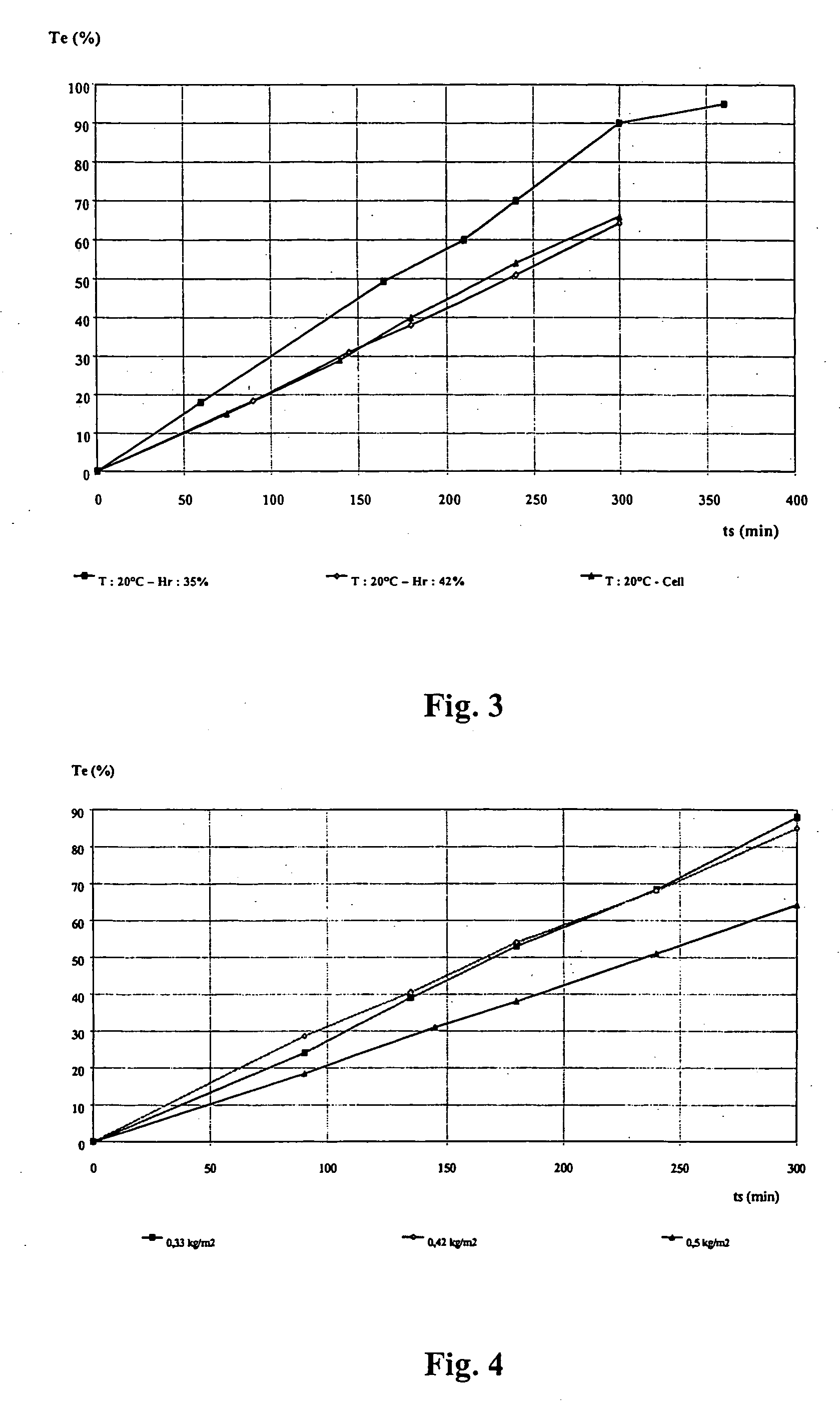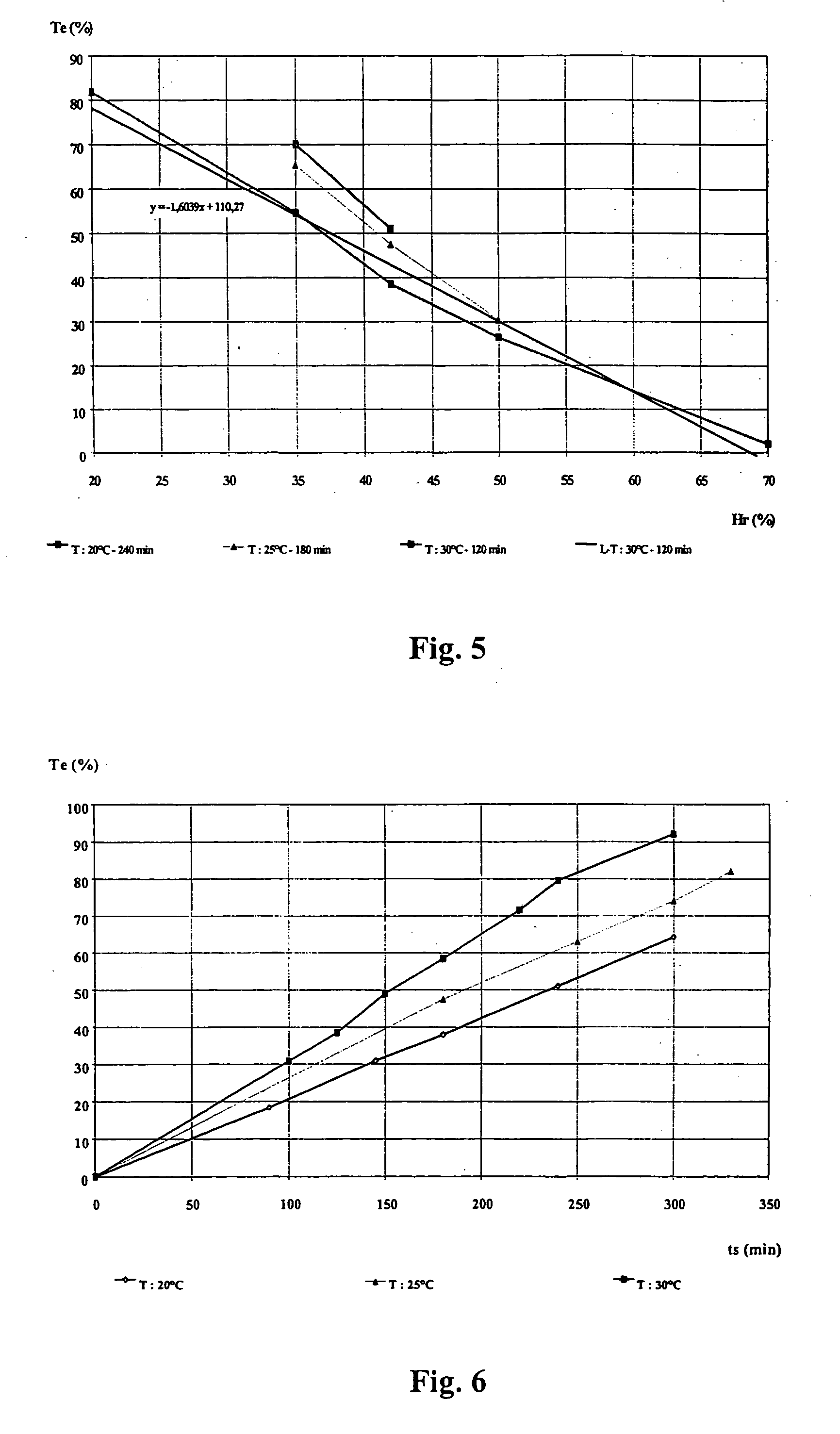Method for treating a surface with a treatment gel and treatment gel
a technology of treatment gel and treatment gel, which is applied in the direction of liquid soap, water/sludge/sewage treatment, low-level cleaning, etc., can solve the problem of generating liquid effluents of the order of 10 l of water after rinsing
- Summary
- Abstract
- Description
- Claims
- Application Information
AI Technical Summary
Benefits of technology
Problems solved by technology
Method used
Image
Examples
example 1
[0069] The drying properties of a gel based on AEROSIL 380 silica, a pyrogenated silica with a high surface area of 380 m.sup.2 / g, are studied in this example.
[0070] Preliminary tests performed by the inventors were able to show that in a concentrated nitric medium 7 M, by using a formulation based on pyrogenated silica, for example of the AEROSIL 380 (trade name) type at a concentration between 8 and 10% by weight, dry residues may be obtained which are easily released after a few hours (between about 2 and 5 hours). Thus, the contact times are sufficient for treating a surface. A silica content of the order of 8% by mass was therefore retained by the inventors.
[0071] The amount of gel deposited on the surface had only a slight influence on the drying features and more particularly on the release capability. Various amounts of gel ranging from 0.1 to 2 kg per m.sup.2 were deposited on surfaces. The amounts from about 0.3 kg / m.sup.2 to 0.7 kg / m.sup.2 are preferred.
[0072] The drying ...
example 2
[0100] In this example, the drying properties of a gel based on a mixture of silicas comprising 8% by weight of AEROSIL 380 (trade name) which is a pyrogenated silica with a high surface area of 380 m.sup.2 / g, and from 0.5% to 1% in weight of FK310 (trade name) precipitated silica.
[0101] The size of the obtained residues after drying in the case of the Aerosil 3080 (trade name) and FK310 mixture, was compared with the size of the residues collected in the case of Aerosil 380 (trade name) silica alone.
[0102] In the appended FIG. 7, photographs of dry residues obtained with the 8% Aerosil 380 (trade name) and 0.5% FK310 (trade name) mixture referenced as "A" on the one hand, and with the 8% Aerosil 380 (trade name) and 1% FK310 (trade name) mixture, referenced as "B", on the other hand, are shown for two drying modes, one at 30.degree. C. and the other at room temperature (25.degree. C.).
[0103] These results show that the size of the dry residues depends very little on the drying cond...
example 3
[0105] The viscosing agent used in this example for preparing alkaline gels is alumina. This is aluminum oxide Al.sub.2O.sub.3 provided by DEGUSSA and for which the primary particle size is around 13 nanometers and the BET surface area is 100 m.sup.2 / g.
[0106] An amount of 15 g of alumina is poured into 100 ml of water or into 100 ml of a caustic soda solution with a determined concentration. The solution is stirred by a mechanical stirrer provided with a three blade stirrer at a speed of 600 to 800 rpm for 2 to 3 minutes. The obtained gel is homogeneous and may be sprayed with a low pressure pump marketed by FEVDI. With an amount of 15 g of alumina for 100 ml of solution, a viscosity may be obtained which allows spraying at low pressure (<7 bars)and this ensures a significant contact time with the wall as the gel does not run down on a vertical wall.
[0107] Four gels were prepared by varying the soda concentration between 0.5 and 5 M.
[0108] Each gel is spread with a spatula uniformly...
PUM
| Property | Measurement | Unit |
|---|---|---|
| oxidation-reduction potential E0 | aaaaa | aaaaa |
| temperature | aaaaa | aaaaa |
| temperature | aaaaa | aaaaa |
Abstract
Description
Claims
Application Information
 Login to View More
Login to View More - R&D
- Intellectual Property
- Life Sciences
- Materials
- Tech Scout
- Unparalleled Data Quality
- Higher Quality Content
- 60% Fewer Hallucinations
Browse by: Latest US Patents, China's latest patents, Technical Efficacy Thesaurus, Application Domain, Technology Topic, Popular Technical Reports.
© 2025 PatSnap. All rights reserved.Legal|Privacy policy|Modern Slavery Act Transparency Statement|Sitemap|About US| Contact US: help@patsnap.com



